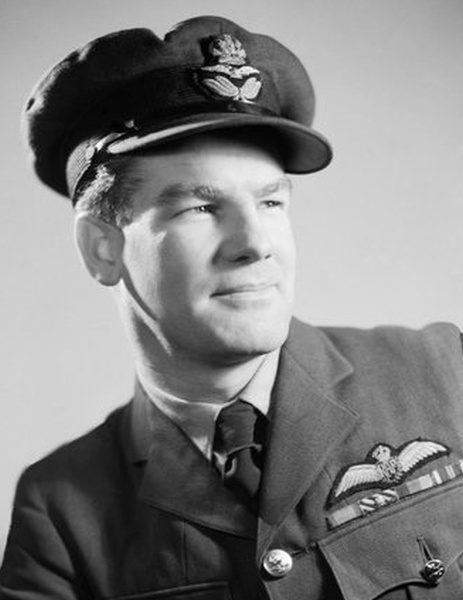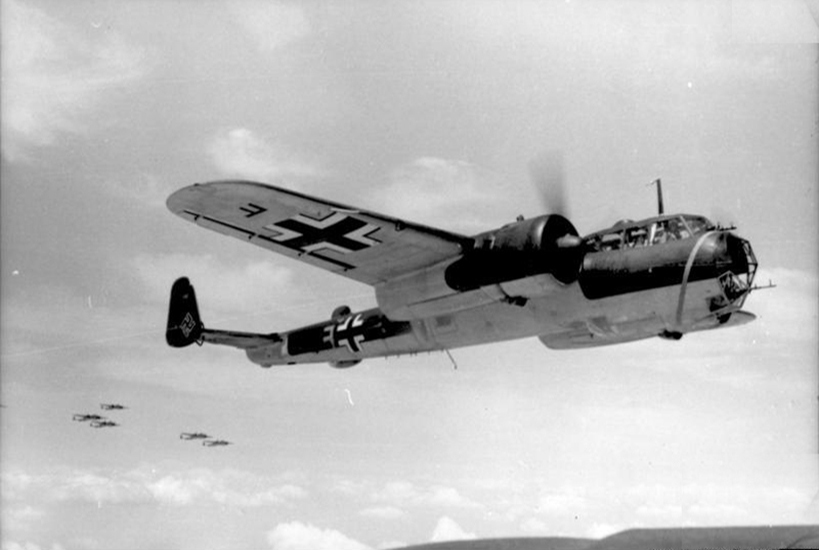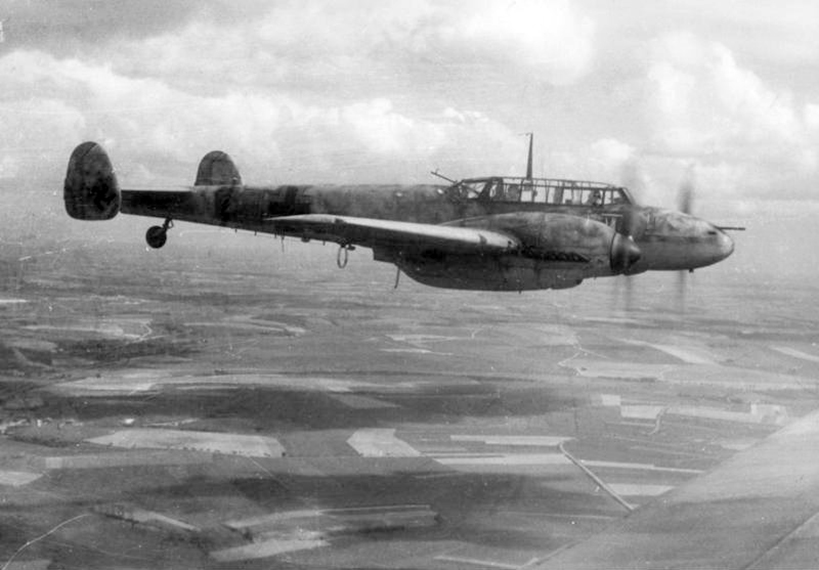Deere, Alan Christopher
- Date of birth:
- December 12th, 1917 (Westport, New-Zealand)
- Date of death:
- September 21st, 1995
- Service number:
- 40370
- Nationality:
- New Zealander
Biography
Alan Deere, possibly the best known of all New Zealand fighter pilots, attended attended Marist Brothers' School and Wanganui Technical College. At the age of eight he saw an aircraft fly overhead and sprinted to see it land on a nearby beach. The pilot allowed him to sit in the cockpit and after that Deere was determined to become a pilot.
After a school career dominated by success in sports, representing his school in rugby, cricket and boxing, Deere worked as a sheep farmer and spent two years as a law clerk. Encouraged by his family doctor to follow his chosen career, Deere persuaded his mother to sign the under 21 application for entry into the Royal Air Force. He passed selection under Wing Commander Cochrane in April 1937 and sailed for England on the Rangitane in September, but was admitted to hospital with high blood pressure.
In September 1937 he travelled to England tot join the RAF on a short service commission and on completion of training was posted to No. 54 Squadron in august 1938 on Gladiators. On 9 January 1938 he was granted a short service commission as acting Flying Officer and started initial officer training at Uxbridge. He was selected for the RAF boxing team to tour to South Africa, but flight training took priority and he was posted to 6 Flight Training School on 22 January. The aircraft he was to have travelled in, crashed at Bulawayo with the loss of all on board.
He first flew spitfires in February 1939.
During May 1940 he was involved in the heavy fighting over the French cost. On 23rd he and pilot Officer Johnny Allen escorted a Master flown by Flight Lieutenant ‘prof’ Leathart to Calais Marck airfield to pick up the commanding officer of 74 squadron, who had force-landed there. Deere and Allen fought an epic battle with Me109’s whilst the pick up was underway, claiming three destroyed and three probables between them. By the end of the month he had already claimed six victories and shares in others and been promoted flight commander. On 28 May Deere was shot down by a Dornier Do-17 he was attacking near Dunkirk. He was knocked unconscious when making a forced landing on a Belgian beach. Rescued by a soldier, Deere made his way on foot to East-Dunkirk where his head injuries were dressed. He hitched a ride on a British Army lorry to Dunkirk, and (after receiving some criticism from soldiers about the effectiveness of the RAF’s fighter cover), boarded a boat to Dover from where he took a train back to London, 19 hours after taking off from Hornchurch with his squadron.
On 9 July Deere shot down a Bf 109 over the channel, but then collided head on with a Bf 109 of 4 Staffel Jagdgeschwader 51 flown by Oberfeldwebel Johann Illner. The propeller blades of Deere's spitfire "Kiwi" were bent backwards, the engine disabled, and much of the fin and rudder lost. Nevertheless, he managed to glide back to the coast near Manston where his forced landing in a paddock ended against a stone wall.
He was shot down and bailed out on 15th and 28th August. On August 31 the Luftwaffe raided Hornchurch. Deere led a section of three Spitfires which attempted to take off during the raid. A bomb destroyed all three aircraft. Deere's Spitfire was blown on its back, trapping him. Pilot Officer Eric Edsall, though badly injured when his own Spitfire had been destroyed, crawled to Deere’s aircraft and freed him. Seeing Edsall’s injuries, Deere then carried his rescuer to the sick bay.
The squadron then withdrew north to rest. While training new replacement pilots in January 1941, Deere collided with one of them, losing most of his tail to the Sergeant pilot's propellor. When bailing out, Deere was trapped against part of his aircraft, and his damaged parachute failed to fully open. Deere landed in an area of open sewerage which broke much of his fall. As a result of this incident he was rested from active flying, but promoted to Acting Squadron Leader and tasked as Operations Room Controller at Catterick. An unusual honour was having his portrait painted by official war artist Cuthbert Orde that February.
In May he was posted as a flight commander to 602 Squadron. On the 10th he was scrambled to investigate a Bf 110 flying westwards. He did not sight the enemy aircraft but after landing was told it had crashed near Glasgow. The pilot was later revealed to be Rudolf Hess.
On 1 august he took over command of the squadron and on that date shot down a fighter over the Channel, which unfortunately turned out to have been a 242 squadron Hurricane. He remained with the unit until January 1942, when he was sent to the USA to lecture on fighter tactics. On return in February he was given command of 403 Squadron, RCAF, and then in, and then in August he was posted to HQ 13 Group on staff duties and attended the Staff College whilst there. In February 1943, anxious to return to operations, he joined 611 Squadron as a supernumerary. Some days later he was appointed Wing Leader at Biggin Hill. He flew 121 sorties during his six months’ leadership and increased his personal score to twenty-two confirmed victories, ten probables and eighteen damaged.
He led the wing until mid-september 1943 when he was taken ill. On recovery, he took command of the Fighter Wing at the Central gunnery School until March 1944 when he joined the staff of 11 Group. In may he became commanding officer of 145 (French) Wing at Merston. After the Normady Invasion he led the wing to an advance airfield in France, but then went to 84 group as Wing Commander, Plans.
In July he took command of Biggin Hill and in August was granted a permanent commission. He was posted to command the Polish Mustang Wing at Andrews Airfield and when the wing disbanded in October, moved to re-open Duxford when it was handed back by the USAAF.
After the war he was posted at numerous stations within the RAF and the Air Ministry
He was also appointed Aide de Camp to HM the Queen between 1961-63. On 30 January 1965 he was given the signal honour of leading fellow Battle of Britain fighter pilots in the main funeral cortege for Winston Churchill. He was consulted for the movie "Battle of Britain".
He retired from the RAF in 1967 but was later employed on a civilian basis at Air Ministry from which he retired in 1977. His autobiography ‘Nine lives’ was published in 1959.
Alan Deere passed away on 21 September 1995 aged 77 years. His ashes were scattered over the River Thames from a Spitfire of the Battle of Britain Memorial Flight.
Promotions:
9 January, 1938: Acting Pilot Officer
28 Octobre, 1938: Pilot Officer
May, 1940: Acting Flight Lieutenant
28 July, 1940: Flying Officer (WS)
1 August, 1941: Acting Squadron Leader
28 July, 1941: Flight Lieutenant (WS)
14 December, 1942: Acting Wing Commander
14 June, 1943: Squadron Leader (WS)
26 March, 1946 [1 Sep 1945], Squadron Leader
3 December, 1946 [1 July, 1943] (T) Squadron Leader
1 July, 1951: Wing Commander
1 January, 1958: Group Captain
1 July, 1964: Air Commodore
Do you have more information about this person? Inform us!
- Period:
- Second World War (1939-1945)
- Rank:
- Pilot Officer
- Awarded on:
- June 14th, 1940
"During May, 1940, this officer has, in company with his squadron, taken part in numerous offensive patrols over Northern France, and has been engaged in seven combats often against superior numbers of the enemy. In the course of these engagements he has personally shot down five enemy aircraft and assisted in the destruction of others. On one occasion, in company with a second aircraft, he escorted a trainer aircraft to Calais Marck aerodrome, for the purpose of rescuing a squadron commander who had been shot down there. The trainer aircraft was attacked by twelve Messerschmitt 109's whilst taking off at Calais, but Pilot Officer Deere, with the other pilot, immediately attacked, with the result that three enemy aircraft were shot down, and a further three severely damaged. Throughout these engagements this officer has displayed courage and determination in his attacks on the enemy."
- Period:
- Second World War (1939-1945)
- Rank:
- Acting Flight Lieutenant
- Unit:
- No. 601 (County of London) Squadron, Royal Air Force
- Awarded on:
- September 6th, 1940
"Since the outbreak of war this officer has personally destroyed eleven and probably one other enemy, aircraft and assisted in the destruction of two more. In addition to the skill and gallantry he has shown in leading his flight, and in many instances his squadron, Flight Lieutenant Deere has displayed conspicuous bravery and determination in pressing home his attacks against superior numbers of enemy aircraft, often pursuing them across the Channel in order to shoot them down. As a leader he shows outstanding dash and determination."
Second DFC awarded as a bar for on the ribbon of teh first DFC.
- Period:
- Second World War (1939-1945)
- Rank:
- Acting Wing Commander
- Awarded on:
- June 4th, 1943
"This officer has displayed exceptional qualities of skill which have played a large part in the successes of formations he has led. His fearlessness, tenacity and unswerving devotion to duty have inspired all with whom he has flown. Wing Commander Deere has destroyed 18 enemy aircraft."
- Period:
- Second World War (1939-1945)
- Rank:
- Acting Wing Commander
- Awarded on:
- January 18th, 1944
"For extraordinary achievement while leading his Wing as fighter escort for medium bombers of the Eighth Air Force on more than 15 missions over enemy occupied Europe. Wing Commander Deere devoted untiring energy assisting in the development of new, untried tactics for medium bombardment aircraft. In order to observe the effectiveness of the new tactics, he personally led his Wing as cover for the bombers on the first mission. The successful bombing of a heavily defended target without the loss of an airplane is in a large measure due to the planning, skill and leadership of Wing Commander Deere. His actions reflect the highest credit upon himself and the Armed Forces of His Majesty’s Government."
- Period:
- Second World War (1939-1945)
- Rank:
- Acting Wing Commander
- Awarded on:
- January 1st, 1946
- Period:
- Second World War (1939-1945)
- Awarded on:
- March 1944
"Wing Commander Deere took part in protective operations covering the Dunkirk evacuation, securing four victories and, two days later, two new victories. He participated in the Battle of Britain. And on 53 occasions he led the French fighter groups “Ile de France” and “Alsace” in operations over occupied territory. His total victories are 21 with an addition of seven probables."
- Period:
- Second World War (1939-1945)
- Period:
- Second World War (1939-1945)
Sources
- Photo 1: Tom MacNeill
- - SHORES, CH. & WILLIAMS, C., Aces High, Grub Street, London, 1994.
- The London Gazette Issue 34873 published on the 14 June 1940
- The London Gazette Issue 34940 published on the 6 September 1940
- Second Supplement to the London Gazette Issue 36041 published on the 1 June 1943
- Supplement to the London Gazette Issue 36335 published on the 14 January 1944
- Supplement to the London Gazette Issue 37407 published on the 28 December 1945
- The New Zealand Fighter Pilots Museum
- Dix Noonan Webb













